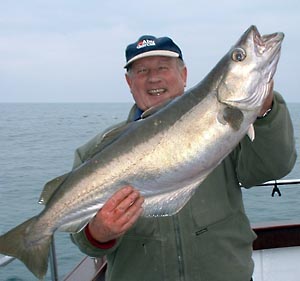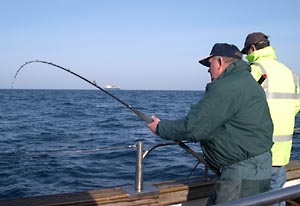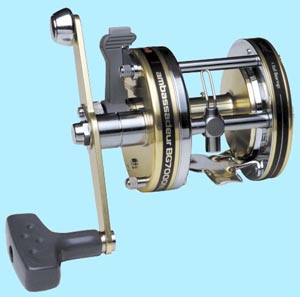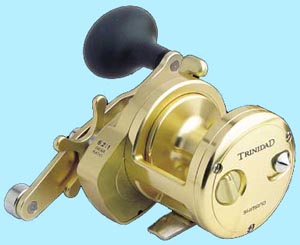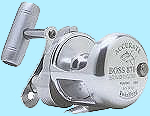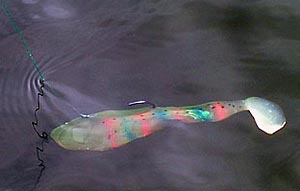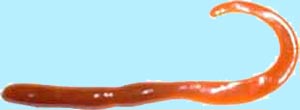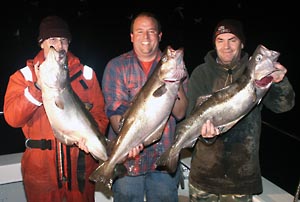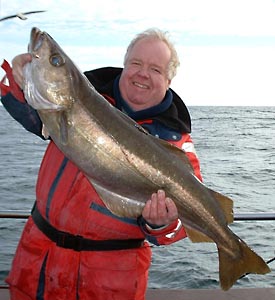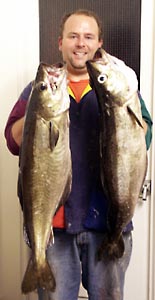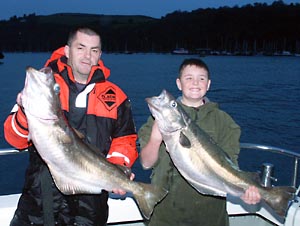 fishing Dartmouth sea angling Devon uk charter boat shore plaice turbot bass river dart |
||||||||||||||||||||||||||
TACKLE TART's POLLACKING
POINTERS |
||||||||||||||||||||||||||
|
Every now and then I receive
numerous Emails and telephone calls from interested visitors to this web
site who seek advice. At the moment we are fortunate to be catching large hard fighting Pollack from mid-Channel wreck marks. If you want to try it yourself and would be grateful for a few tips and general pointers, here goes, I trust you will find this helpful.
I usually wear my “Shakespeare Navigator” two piece flotation suit. It keeps me dry and warm. Should I have the misfortune to fall into the sea, it will keep me afloat and insulated from the thermal shock of the cold water long enough to have a reasonable chance of being rescued. I take a “Shakespeare” seat box crammed with various “Shads”, “Jellyworms”, and “Redgills”, separated in “Tupperware” plastic containers. It’s important to keep the various types of lures apart. If you doubt this necessity, try putting several plastic jelly worms into a polythene bag together with a clear Perspex box such as the ones you buy hooks in. The adverse chemical reaction will dissolve the Perspex within days, leaving a horrible unusable ‘sticky’ mess. I also carry a razor sharp filleting knife, an effective knife sharpener, a roll of strong polythene sacks for my fish fillets, a pair of reliable digital scales, a spare reel loaded with line, a bag of feather lures, and cloths for wiping fish slime from my hands. A 2 gallon plastic bucket conveniently holds a variety of lead weights from 2 to 12 ozs. A good pal in Torquay has been moulding "Canon Ball Sinker Weights" in 8 oz and 10 oz sizes. These are particularly good as they don't spin and seem less inclined to snag in the plates of some rusty hulk 200 feet below. He will supply these at 45 x 8 oz or 40 x 10 oz weights for £25. Collect from Torquay area - carriage is extra. Call Dave on 07748 240286 to order your own. I am very pleased with my recently bought ”Plano 777” tackle box which contains hooks, swivels, sliders, booms, beads, spare line, braid scissors, long nosed pliers for removing deeply embedded hooks, trace material, and all the other gadgets we may need, together with some that we never do. With jellyworms and unweighted rubber shad lures, I prefer to use the Partridge “Sea Beast” range of hooks in size 6/0. They are available through “Shakespeare” tackle dealers. If your local shop does not stock this top quality range, ask them to order them for you. These hooks really are very strong and needle sharp and competitively priced. A couple of 20 lb class rods, with reels already attached are essential. I always like to take a spare. On my last trip, the tip eye on one of my rods unexpectedly failed while far out at sea. I was able to continue to fish using my second rod. On many occasions I have loaned my spare rod to a pal who has damaged their own. There is nothing worse than being miles offshore and unable to fish due to broken tackle. I have an “Abu Garcia Suveran” 20 to 30 lb class 7 foot 9 inch boat rod which I love.
I also have a matched pair of Northwestern Rodcraft “Kevlar” 8 foot 20 lb class boat rods which I find ideal for Pollack fishing. What’s the difference? The “Suveran” is a soft actioned rod, with “Fuji Concept” single leg guides. It is a pleasure to use, particularly when fishing with braid line, which has no inherent stretch and requires the spring effect of a pliant rod to prevent snap-offs. The “Northwestern” rods are light in weight and far stiffer. I enjoy them when fishing with monofilament line. My pals use various rods of similar weight from other manufacturers such as Daiwa, Shakespeare, Penn, Ron Thompson and Fladen, with great success. The most important factor is the inherent characteristics of the tackle you choose to suit your preferred style. A multiplier reel loaded with line of about 20 lb breaking strain is ideal. I like to use a level wind reel, similar in size to an Abu 7000 model. I have an elderly Abu Morum 7700 which is no longer manufactured and I love it. I have two of the Abu 7000 Big Game series reels with star drag. I have several Abu 7000 lever drag models of varying age. The new Abu 7000 gold coloured “Big Game” lever drag reel is particularly easy to use.
The newly introduced Abu 7000 narrow width spool model is particularly suited for use with braid line. I’ve got several Penn reels with star drags. I have Shimano reels with various lever and star drag controls. I really enjoy using my Shimano “Trinidad” 30 lb class model which has a 6.2 to 1 retrieve rate and no level wind. It has one of the smoothest jerk free clutches of any reel I have ever owned.
Patsy loves her beautiful reel, manufactured in the USA. It is an “Accurate Boss B-270M” with twin clutch and lever drag. I prefer the next size up, the “Accurate B-870M” which is ideal. I've recently bought myself a matched pair of B-870M's and you can read a complete review on this web site via the "Tackle Tips" page.
You can view Accurate reels on the Internet at www.accuratefishing.com They really are very special and built to the exacting standards you might expect of a Rolex watch. The most important factor is that your reel is mechanically sound, well maintained and loaded with good quality line. If you have old monofilament line which has been on your spool for ages, then change it for new. It does degrade over a period of time. Replacement line is inexpensive. Make certain that you set your clutch correctly so that a big fish on its first powerful dive can take line without breaking you off. It is anglers who lose fish, not fish who break off anglers. I should know I’ve lost more than my fair share of good Pollack during my chequered career. I keep my terminal tackle very simple. I thread my line through a tubular plastic boom, to which I attach a lead weight of anything between 6 and 12 ounces, depending on the depth of the water, the flow of the tide and speed of drift of the boat. After that, I put a bead onto my line and finally tie a Berkley 80 lb swivel on the end. The bead prevents the boom from chafing or jamming over the knot on the swivel. On spring tides I sometimes use a running lead link followed by four black 8 mm beads in place of a boom as it allows the line to run more freely through it. I call it my “flexi boom”. This works well for shy biting fish. Occasionally, I prefer to use a French wire boom made from thin stainless wire, which keeps the lure well clear of the main line, particularly important when fishing rubber eel lures on very long traces. My pal Dean Corbett used to bend his own wire booms from discarded coat hangers, they worked perfectly well, though we’ve since converted him, after much teasing, to use proprietary fishing tackle. 30 lb “Amnesia” clear monofilament functions very well as a hook length from the swivel to the preferred lure. I use 30 lb trace rather than a lighter breaking strain as it absorbs to some extent the effect of chafing against the rusting metal plates of a wreck in 200 feet plus of water. I was told by a charter Skipper, that the slightly heavier and stiffer mono line causes the lure to work more effectively. He maintained that the motion through the water causes a thinner trace to move, rather than the lure to wriggle attractively. Mono line has the advantage of some inherent stretch which cushions the crash dive and head banging of a big angry fish. Braid line is much thinner and presents far less water resistance so you can often fish with less weight to get your lure down in deep water through a fast running tide. If you are fishing on a crowded boat with pals who are using mono, I suggest you do the same as it will result in far less time wasted with tangles. I prefer to fish with braid line as it feels far more direct and sensitive, but I bow to the majority and go with the crowd when I’m out with friends, particularly when charter fishing. When using braid main line, I always tip it off with about 3 metres of mono as a rubbing tip which can be readily replaced. Always change your line if it shows any sign of having been chafed. If you don’t, that big fish may get away. To lose a fish because it fights hard is excusable, but to lose it because of your own carelessness is unforgivable. Learn to tie a “double grinner” knot to join braid securely to mono. It’s far simpler to tie swivels quickly onto mono than to braid. I am often asked to show fellow anglers a successful way of tying a braid fishing line to a monofilament or fluorocarbon leader line. I recommend and use the "Double Grinner" knot, which works and has never let me down. The "Double Grinner" knot is what is known as a 100% knot, which means that because it does not cut into itself, it is 100% as strong as the breaking strain of your line. Many other knots will weaken the integrity of the lines by as much as 50% of their breaking strain and I do not use them for that reason. Watch this video clip which I have recorded for your information and learn to tie this useful knot in the comfort of your own home, until you can tie it without any problem, particularly when you have to do so on a rocking boat in a rough sea. It lasts around 7¾ minutes and is easy to view on a Broadband connection.
How NOT To Do It - I have also shown you in my next video clip, a superficially similar knot which is NOT a 100% knot, and which I actively discourage you from using. Watch, learn, and understand why. This clip lasts around 4¾ minutes and is easy to watch on a Broadband connection.
I want to see you all catch very big fish, without any tears and troubles. Preparation goes a very long way towards eventual success. The favourite lure which has caught many specimen fish from wrecks during the past couple of seasons is the lead headed holographic “Shad”. Weighted Shads are simple to fish and need a relatively short leader. Two metres is more than enough. I have caught superb fish on these lures using a leader just 4 feet long.
Lures which contain their own internal lead weight are far easier to lower smoothly to the ocean floor without them becoming wrapped around your main line. On charter trips you will probably be fishing close to your fellow anglers. A shorter trace reduces the chance of becoming tangled with their flowing rigs. So you ask, “Why should I use a short leader?” There are two valid reasons. As you drop a weighted lure it reaches the bottom before your heavier main lead, which is attached to your boom. As you start to reel your rig back up, the weighted lure remains in the wreck for a few moments longer, increasing your likelihood of becoming snagged, proportionate to the length of time it stays there. Unweighted “Shads” can be fished on a 6/0 hook and a longer trace. Martin Cosgrave, a top local bass angler, reckons he can successfully fish them through the wreck, closer to the structure. Always put a swivel in the middle of longer traces which may extend to 12 feet or more as this will minimise line twists.
Lures such as Jelly worms can be fished on smaller hooks, though such hooks must still be strong and capable of withstanding the fierce head banging of an angry Pollack.
Jelly worms and various “Redgills” or “Eddystone Eels” all fish well, particularly on the smaller tides, when the extra wriggling movement they provide can tempt shy fish to feed.
The newly introduced “Storm” artificial Sand Eels look particularly enticing. Whatever lure you choose, be prepared to experiment with size and colour until you find the one that the fish prefer at that time. Always look to see what the fish which are brought aboard are coughing up. Today the Pollack were regurgitating partly digested Anchovies and Smelt; small thin silver fish about 4 inches in length. A couple of trips ago, they were seen to have been feeding on “Sprats”, small Herring about 5 inches long. Another day it was Sandeels. Fish undoubtedly see colours in a different way to humans. Last week dark green Shads were the preferred bait. Yesterday, blue and silver or plain white worked far better. Try different colours of rubber eels too, the orange colours seem to attract Cod. Personally I believe that selecting the right size of lure is probably more important than the colour. I guess the purist fly fisher for trout and salmon would refer to it as “matching the hatch”. How do we fish these lures? Your Skipper will set up the boat to drift on the wind and tide over the wreck. You simply thumb the spool to prevent over-runs and let your tackle slowly down to the ocean bed. If you let it down too fast your lure and trace will become hopelessly tangled around your main line. Wind your reel to bring the lure back up perhaps 50 turns. The number of turns will vary, depending on the size of the wreck and the level at which the Pollack are shoaling adjacent to it. Then let your lure back down and repeat the operation. You will feel a “pluck” as the Pollack takes your lure. Sometimes the fish will just pull at the rubber tail. Whatever you do, do not strike. Just keep winding without a pause and the fish will usually follow and take your lure. You will know when you are connected to a big fish. Often, the first indication will be when your line locks up and you momentarily believe you have snagged the wreck. The next thing you will feel is the wreck kicking and bucking. It is then that you realise that what you thought was the wreck is in fact a big fish making its desperate bid for freedom. You will quickly understand why I advised you to pre-set the tension on your clutch properly. You must be certain that these fish can take line against the drag of the clutch and you must utilise your rod tip to cushion their violent dives.
Now for the best part, pumping your fish back towards the surface; lift your rod tip smoothly and then wind line back onto your reel as you lower it. If the fish crash dives again, let it pull off line against the clutch. Never try to retrieve line when a fish is diving and taking line. Don’t allow a fish slack line or it will throw your hook. Never try to bully it if it wants to dive let it take line against the clutch of your reel. Don’t be over zealous, “little and often” is probably the safest maxim. This is where you really do learn what is meant by “playing” a big fish as you use your rod correctly to pump line back on to your reel. When one of your fellow anglers catches a fish, don’t be bashful ask, “How many turns up were you?” The reply whether “6” or “24” will let you work out at what general depth the fish are to be found. Try varying the speed of your own retrieve. One day the fish will chase a lure which is reeled in quite fast, on another occasion they prefer a slower action. Find out by trial and error. When I fish with my regular pals, we often call out as soon as we hit a fish, “30 turns up on a slow retrieve”. We share such important information for the common benefit.
Expect to lose a fair amount of tackle on the wreck. It goes with the territory. You’ve often got to fish close into the wreckage to catch the best fish, particularly near slack water. You will meet plenty of opportunities to practise replacing your gear and tying knots. Use a landing net or gaff to assist in boating specimen fish. If you want to learn to use a net or a gaff well, then watch an experienced charter boat crew. Always allow the angler to bring the fish to the net and then lift the net into the boat with the handle vertical so that the top of the net is closed and the netting is hanging down against the rim of the net, securely holding the fish. If you lift a landing net containing a big fish horizontally, you may well break the net off the handle.
Gaff a fish under the head if you can, with the hook of the gaff placed outside of the fish, pulling the fish back towards the boat, as you neatly insert its point. Never lunge towards a fish with either a net or a gaff. If you carelessly knock off the fish of a lifetime through your own clumsiness, you will not make yourself popular with your fellow anglers, although accidents will happen.
Tidal flow is a very important factor. On the smallest neap tides, or around slack water, insufficient water will be moving in the depths to cause the resident Pollack to want to feed. It’s a very simple principle. Fish will not rush around is search of food if in doing so, they use up more energy than they get from that food. They wait for tidal movement to bring their preferred diet to them. Sure, you will quite often pick up an occasional fish at slack water, probably when your lure passes close enough to antagonise it, but the majority will come onto the feed as tidal flow increases. On the biggest tides, your boat will drift across the wreck at higher speed increasing you chances of snagging the rusty hulk while decreasing your lure’s time in the catch zone. When you get it all right the results can be spectacular and memorable. I hope this has whetted your appetite and interest to try winter Pollack fishing. Do give it a go. I know you will find it most exhilarating. You will be hooked! |
